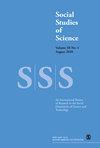作秀:通过faalade的比喻解读政府空洞创新的例证。
IF 2.7
2区 社会学
Q1 HISTORY & PHILOSOPHY OF SCIENCE
引用次数: 0
摘要
本文考察了政府技术示范中的意义建构,以及它对持久创新机制产生的意义。STS文献主要涉及商业技术产品背景下的技术演示,并通过公共知识制造的镜头:作为引发对事实的信任的事件。我将注意力转向一个新的背景,即政府创新,并通过其美学和情感注册而不是认识论来接近格式,从而促成了这一讨论。在一个旨在建立一个名为AuroraAI网络的政府软件系统的项目过程中,用于赋予福利主体权力,芬兰财政部政府信息通信技术部制作了一系列四个高度戏剧性的活动,试图展示人工智能系统的发展。使用社会符号学绩效分析,我将这些事件分析为一种假象,一种呈现技术演示的陷阱,但不是推进具体的技术事实,而是产生对政府创新的情感和审美敏感性。本研究以“虚荣心”为隐喻,揭示了“虚荣心”创新是如何得以持久和成功的。本文章由计算机程序翻译,如有差异,请以英文原文为准。
Making a show of it: Reading demonstrations of empty government innovation through the metaphor of façade.
This article examines meaning-making in a governmental technology demonstration, and its significance in the production of a durable artifice of innovation. STS literature has largely engaged with technology demonstrations in the context of commercial technology products, and through the lens of public knowledge-making: as events that elicit credence in matters-of-fact. I contribute to this discussion by turning attention towards a new context, governmental innovation, and approaching the format, not through its epistemics, but rather its aesthetic and affective registers. Over the course of a project aimed at building a governmental software system called the AuroraAI Network, to be used for the empowerment of welfare subjects, the Department of Government ICT at the Finnish Ministry of Finance produced a series of four highly theatrical events that sought to demonstrate the development of the AI system. Using social-semiotic performance analysis, I analyse these events as a kind of façade, one that presents the trappings of technology demonstration, but rather than advancing specific technical matters-of-fact, produces an affective and aesthetic sensibility of government innovation. By mobilizing the metaphor of façade, this research shows how empty innovation is made durable and successful.
求助全文
通过发布文献求助,成功后即可免费获取论文全文。
去求助
来源期刊

Social Studies of Science
管理科学-科学史与科学哲学
CiteScore
5.70
自引率
6.70%
发文量
45
审稿时长
>12 weeks
期刊介绍:
Social Studies of Science is an international peer reviewed journal that encourages submissions of original research on science, technology and medicine. The journal is multidisciplinary, publishing work from a range of fields including: political science, sociology, economics, history, philosophy, psychology social anthropology, legal and educational disciplines. This journal is a member of the Committee on Publication Ethics (COPE)
 求助内容:
求助内容: 应助结果提醒方式:
应助结果提醒方式:


